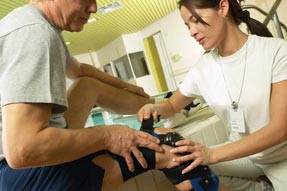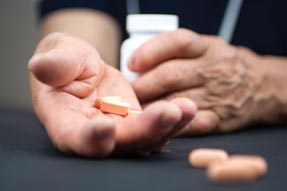Noninvasive treatment almost always best for knee pain
Knee symptoms are the most common musculoskeletal reason why patients visit their doctors, and in most cases, except when breaks or infection is suspected, physicians should recommend the use of nonsurgical treatments first.
The complexity of the knee as a joint can sometimes make caring for it as much of a pain for primary care physicians as for their patients.
Knee symptoms are the most common musculoskeletal cause of presentation to physician offices in the United States, according to data from the 2012 National Ambulatory Medical Care Survey. And a patient presenting to a physician with knee pain could be dealing with 1 of any number of issues, including osteoarthritis, injury such as sprains or ligament tears, gout, rheumatoid arthritis, or, in some cases, Lyme disease, explained Theodore R. Fields, MD, FACP, professor of clinical medicine at Weill Cornell Medical College in New York.

These are the factors that make evaluation and treatment difficult for primary care physicians, according to Gregory Hood, MD, MACP, an internist with Drs. Borders, Hood and Associates in Lexington, Ky.
“The mistake a lot of patients and care providers make is to think of the knee as 2 bones that slap up next to each other at the joint, but the knee is so much more than that,” Dr. Hood said. “The knee depends on muscles, ligaments, and tendons to be in good balance and properly maintained in order to function properly.”
Evaluating knee pain
Despite the knee's complexity, Dr. Hood said that imaging or testing will not be needed to make an accurate diagnosis most of the time. Instead, 70% of a workup for knee pain should be taking a patient's history, 20% should be physical examination, and only 10% should be testing.
While obtaining a patient history, physicians should address simple questions first, such as when the pain started, according to Dr. Fields. If it occurred during athletics, did the patient hear a snap or feel something twist? Did the knee get swollen or black and blue? Does the knee seem unstable? These are all important clues that there might be a structural injury, such as a torn meniscus, he said.
When knee pain is not associated with athletics or activity, physicians must begin to think about chronic, nontraumatic causes. Important questions include asking about the stiffness of the joint or pain after exercise or presence of arthritis elsewhere in the body, Dr. Fields said. If Lyme disease is suspected, ask a patient about tick bites or the presence of a rash. If gout is suspected, ask patients if they have had previous episodes of pain, swelling, or stiffness, usually in the big toe.
Nonsurgical approaches
In most cases of knee pain, except when breaks or infection is suspected, physicians should recommend the use of nonsurgical treatments first, according to Colleen Christmas, MD, FACP, director of the primary care leadership track at The Johns Hopkins University School of Medicine in Baltimore.
When dealing with an injury, physicians should recommend RICE, or rest, ice, compression, and elevation. Patients can also use over-the-counter medications or creams to help with knee pain, or physicians can prescribe pain medications or anti-inflammatories, she said.
Patients who have knee pain due to osteoarthritis may be ideal candidates for referral to physical therapy, according to Dr. Fields, who is also director of the Rheumatology Faculty Practice Plan at the Hospital for Special Surgery in New York and an attending physician there.
“I usually try about 6 weeks of therapy and see how much that is able to help them,” he said.
This approach has 2 advantages, according to Dr. Fields. First, if patients combine physical therapy with medications, they may find that they are doing pretty well and can defer surgery. Second, if surgical intervention is ultimately required, “we know that patients who go for knee replacements who have strengthened their leg ahead of time have better recovery,” he said.
According to Dr. Hood, most physicians also receive training in cortisone knee injections, which may help with short-term pain relief. However, a study presented at the American College of Rheumatology's annual meeting in 2015 by Timothy E. McAlindon, MD, FACP, of Tufts University in Boston found that intra-articular steroid injections may not effectively prevent structural damage from osteoarthritis over the long term.
The 2-year study randomly assigned 140 patients with symptomatic osteoarthritis to either intra-articular triamcinolone hexacetonide (THA) or saline and evaluated cartilage damage using MRI. The study showed no significant difference in the measures of knee pain or function between the 2 groups. The analysis of structural differences also revealed almost no differences between the patients who were treated and those who were not, with the exception of a small difference in loss of cartilage thickness in favor of the THA group.
Weight loss
Weight loss can also play a substantial role in alleviating knee pain, according to Dr. Hood.
“I have had patients that were narcotic dependent for chronic knee pain that, through sufficient weight loss and mobilization, were able to successfully terminate their relationship with controlled substances for knee pain,” he said. “Every pound a person gains puts 4 to 5 pounds of pressure on the knee, and every pound they lose takes it off.”
In fact, a small study published in 2012 in Arthritis looked at the effect of weight loss after bariatric surgery on osteoarthritis-related knee pain in 24 patients with a body mass index greater than 35 kg/m2. Patients in the study had significant weight loss at 6 and 12 months after surgery, as well as significantly improved knee arthritis symptoms at 6 and 12 months.
Additionally, a study published in Annals of Rheumatic Diseases in 2014 showed that among 112 obese participants recruited from weight loss programs, the percentage of weight loss was associated with a reduction in medial cartilage volume loss and improvement in knee symptoms.
In addition to weight loss, it is important for overweight or obese individuals with knee pain to also strengthen their knee through exercise, Dr. Christmas said.
“Overweight people very often tend to be more sedentary, which weakens the muscles to help support the knee and keep it properly aligned,” she said. “Weight loss coupled with exercise can help to realign the joint and strengthen it, allowing patients to forgo medications.”
Surgery
Despite effective nonsurgical approaches, referral to an orthopedist for surgery may be necessary in patients with fractures or tears or in those with chronic debilitating and progressive knee pain, Dr. Christmas said.
However, the decision to undergo surgery should not be made lightly, she added.
A study published in 2014 in Arthritis & Rheumatology showed that about one-third of total knee arthroplasty surgeries done in the United States may have been inappropriate for patients presenting with only mild arthritis. Another study published in 2015 in Arthritis Care compared outcomes in patients who were deemed inappropriate or appropriate candidates for surgery, with appropriateness defined using a modified algorithm developed in Spain by Escobar and colleagues from the results of a large review of clinical scenarios taken from patients who underwent total knee arthroplasty. The study showed that patients who were inappropriate candidates for surgery had only mild improvements in knee pain compared with large improvements seen in patients deemed appropriate candidates.
Dr. Hood said that physicians should also explain to patients the risks of surgery.
For example, a study published in 2015 in Arthritis & Rheumatology showed that patients who underwent total knee arthroplasty had an almost 9-fold increased risk for myocardial infarction in the month after surgery compared with matched controls, although this risk declined with time.
However, surgical risks are not just acute or perioperative, Dr. Hood said. Knee replacements are mechanical devices that wear out and may require replacement.
“If a patient goes to surgery prematurely, they may have to have it redone a second or third time,” Dr. Hood said. “Each time the knee is replaced there is a risk of tibia shortening, which puts pressure on the contralateral limb.”
Physicians need to help patients understand that most knee pain is chronic and that the goal is to manage it so they can continue to enjoy their lives, Dr. Christmas said. That may mean that the patient needs to make lifestyle changes, such as weight loss and exercise, and that the physician has to introduce medications along the way.
“For most people, the pain can be controllable, but the key is to not make too many promises,” she said. “In many cases, it is important for patients to realize that their pain may not ever go away and that they are always going to have some discomfort.”




